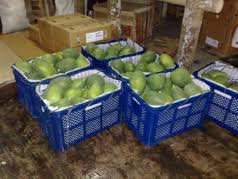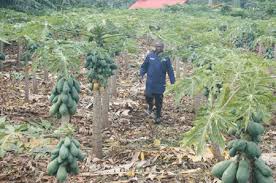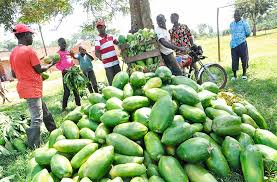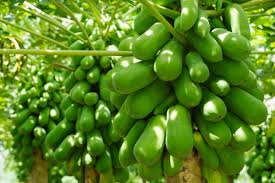The pawpaw, also known as papaya, belongs to a small and somewhat unique family comprising four genera. Three of these genera are found in tropical and subtropical America, while one is native to Africa. Carica papaya belongs to this family.
Typically, the pawpaw is a small tree characterized by terminal clusters of leaves, which are spirally arranged and lack stipules. It is often dioecious, meaning male and female flowers are borne on separate plants.
Origin and Distributions
Carica papaya has never been discovered in the wild, but it is likely that it originated in Southern Mexico and Costa Rica. From these regions, it has since spread to all tropical and subtropical countries across the globe.
Uses of Pawpaw

The ripe fresh fruits of Carica papaya are commonly consumed at breakfast, as dessert, or in fruit salads. Pawpaw fruits can also be used to make soft drinks, jam, ice cream flavoring, crystallized fruit, and canned products in syrup. Unripe fruits are often cooked and used as a substitute for mango or apple sauce.
Pawpaw latex, extracted from the dried latex of immature fruits, contains a proteolytic enzyme similar in action to pepsin. This enzyme is utilized in meat-tenderizing preparations, the manufacture of chewing gum, cosmetics, and as a remedy for digestive ailments.
It is also employed in the tanning industry for bating hides, degumming natural silk, and providing shrink resistance to wool.
Young leaves are occasionally eaten as spinach, while sweet dishes can be made from the flowers. Both the leaves and young fruits are used to tenderize meat.
In some countries, the seeds are used as a vermifuge, counter-irritant, and abortifacient. Additionally, pawpaw fruits have been found to have medicinal properties, including potential benefits for conditions such as fibroids, tuberculosis, and malaria.
Read Also: For how long can I store feeds before giving them to the fish?
Pawpaw Varieties
There are several named cultivars of Carica papaya, though maintaining them can be challenging in dioecious plants. One of the best varieties is the hermaphrodite “Solo,” introduced from Barbados. The fruits of this cultivar are pyriform (pear-shaped), measuring approximately 10 x 15 cm and weighing around 2 kg.
Ecology, Fruit and Seed of Pawpaw

Pawpaw is a tropical plant cultivated in latitudes up to 32°N and S, as it is highly sensitive to frost and can be easily killed by it. Near the equator, it produces good yields at elevations up to about 1,700 meters. The plant requires full sun and benefits from windbreaks to protect it from strong winds.
Low temperatures can result in fruits with poor flavor. It thrives in well-drained, fertile soil with a pH of 6–6.5. Pawpaw cannot tolerate waterlogging, so proper drainage is essential. In dry regions, irrigation is necessary to support its growth.
The pawpaw fruit is a fleshy berry, measuring 7–30 cm in length and weighing up to 9 kg. Its shape varies depending on the type of flower: ovoid-oblong to nearly spherical from pistillate flowers, and pyriform, cylindrical, or grooved from hermaphrodite flowers.
The skin is thin, smooth, and green when unripe, turning yellowish or orange when ripe. The edible flesh has a buttery consistency and a mild, pleasant flavor. The central cavity is 5-angled.
The fruit contains many parietal seeds, attached in five rows to the interior wall of the ovary. The seeds are spherical, about 5 mm in diameter, and black or grayish with a wrinkled appearance. They are enclosed in a gelatinous sarcotesta formed from the outer integument.
The embryo is median and straight, with ovoid, flattened cotyledons surrounded by fleshy endosperm. There are approximately 20 dried seeds per gram.
For successful germination, the gelatinous envelope must be removed from the seeds before planting. Air-drying the seeds helps retain their viability for 2–3 years. Germination typically takes 2–3 weeks and is epigeal, meaning the cotyledons emerge above the soil during the process.
Chemical Composition
The edible portion of fresh fruit contains approximately:
| 88% | – water |
| 10% | – sugar |
| 0.5% | – protein |
| 0.1% | – fat |
| 0.1% | – acids |
| 0.6% | – ash |
| 0.7% | – fibre |
Pawpaw is a rich source of vitamin A and has some vitamin C. The latex contains the enzymes papain and chymopapain, both of which have protein – digesting and milk clotting properties.
Pawpaw Propagation

Pawpaw is normally propagated by seed. Seeds can be planted in wooden flats and placed in the sun while the cotyledons are still large and green. About 3–4 weeks after germination, the seedlings can be transplanted into containers or polythene bags.
At 8–10 weeks after sowing, when the seedlings reach a height of 15–20 cm, they are ready for transplanting to the permanent orchard site.
Alternatively, pawpaw seeds can be sown directly into nursery beds at a depth of 15 cm and a spacing of 10 x 2.5 cm. Approximately 2,400 seedlings are needed to plant one hectare. For papain production, seeds are typically sown at stakes with 10–30 seeds per hill.
After germination, thinning occurs to leave about five plants per hill, allowing them to grow for six months until flowering, when the sex of the plants can be determined. Ultimately, one female plant per hill is retained, along with one male plant for every 25–100 female plants. When cultivating hermaphrodite cultivars such as “Solo,” female plants are removed to ensure uniform fruit size and shape.
Pawpaw can also be propagated vegetatively through cuttings or grafting; however, this method is not economically viable for commercial production and is primarily considered an academic exercise.
Field Establishment
The usual spacing for pawpaw planting is 2–3 meters apart. It may be necessary to water the transplants and provide shade using bracken or other suitable materials.
After cultivation should primarily focus on weed control. Intercropping with vegetables or leguminous crops is possible before the pawpaw canopies are fully established. Mulching, especially during the initial stages, is beneficial for moisture retention.
Good responses can be achieved by applying organic manure and nitrogenous fertilizers. A recommended fertilizer is NPK (15:15:15) at a rate of 0.9 kg per mature tree. Pawpaw trees typically begin bearing fruit between 9 and 14 months after planting.
While a pawpaw tree may live up to 25 years theoretically, its yield declines with age. For practical purposes, the productive life of a pawpaw tree is generally no more than three years.
Pawpaw Harvesting

For fresh fruit, harvesting can begin when the first traces of yellow appear on the skin, as the fruits will ripen fully in 4–5 days. Fruits should be cut from the tree using a sharp knife.
Pawpaw yields can vary significantly, with trees producing between 30 and 150 fruits per annum. This can result in up to 35 tonnes of marketable fruit per hectare under optimal conditions.
Pests and Diseases of Pawpaw
The most serious disease that may affect pawpaw is a mosaic virus, which stunts the plants. This virus causes yellow mottling and distortion of the leaves, bending of petioles, and can eventually lead to the death of the tree.
Infected plants typically yield very little or nothing at all. In some areas of Nigeria, it has become nearly impossible to grow pawpaw due to this virulent virus.
The mosaic virus is transmitted by vectors such as Aphis spp., and in Hawaii, a major pawpaw-producing region, Myzus spp. are the primary vectors. Additionally, the bunchy-top virus, vectored by the leafhopper Empoasca papaya, can also pose a significant threat.
Under waterlogged conditions, Pythium spp. can cause collar-and-foot-rot in pawpaw plants. Anthracnose, caused by Colletotrichum spp., leads to spotting on ripe fruits. Among pests, mites are the most damaging to pawpaw, and some bird species also cause damage to the fruits.
Read Also: Maggot Feeding: Can You Feed Fishes with Maggots?
Pawpaw Production

Most of the pawpaw crop in the tropics is consumed locally due to the challenges of transporting the fruits over long distances without damage.
Fresh fruits are exported by air and in cold storage by sea, primarily from Hawaii to the United States, but limited quantities reach other temperate countries. Increasingly, pawpaws are being canned, and this market is expected to grow.
Tanzania has emerged as the world’s leading producer of pawpaw, with an annual production of approximately 200,000 tons. Smaller quantities are produced in Uganda, while Nigeria’s production does not meet domestic demand, especially in large cities.
The United States is the primary importer of papain, a product derived from pawpaw. However, the market for papain is highly sensitive to overproduction.
In conclusion, pawpaw is widely cultivated throughout the tropics for its edible fruits. The ripe fruits are consumed fresh, used in soft drinks, desserts, and fruit salads, while unripe fruits are cooked as a substitute for marrow or apple sauce.
Papain, a proteolytic enzyme extracted from the latex of pawpaw, is used in meat tenderizing preparations, among other applications. Additionally, young leaves are eaten as spinach, and the seeds are utilized as a vermifuge, counter-irritant, and abortifacient.
Pawpaw can be propagated by seeds, vegetatively through cuttings, or by grafting. This versatility in propagation methods supports its widespread cultivation and utilization across tropical regions.
Do you have any questions, suggestions, or contributions? If so, please feel free to use the comment box below to share your thoughts. We also encourage you to kindly share this information with others who might benefit from it. Since we can’t reach everyone at once, we truly appreciate your help in spreading the word. Thank you so much for your support and for sharing!
Read Also: The Impact of Inefficient Waste Management on Oceans

